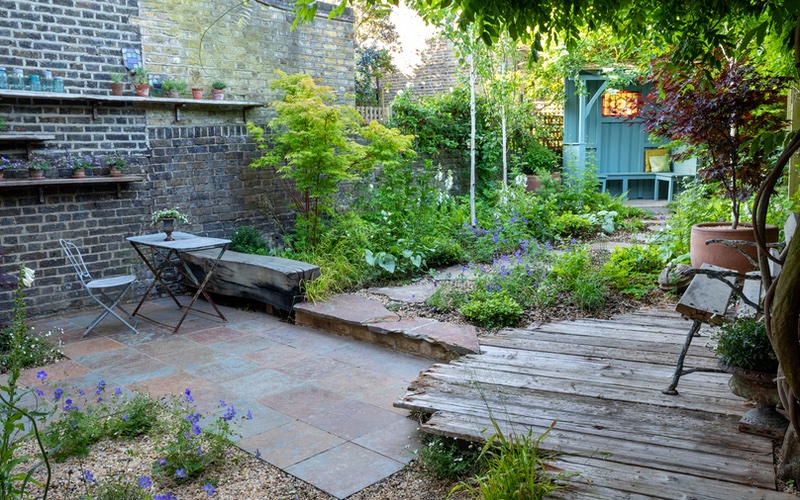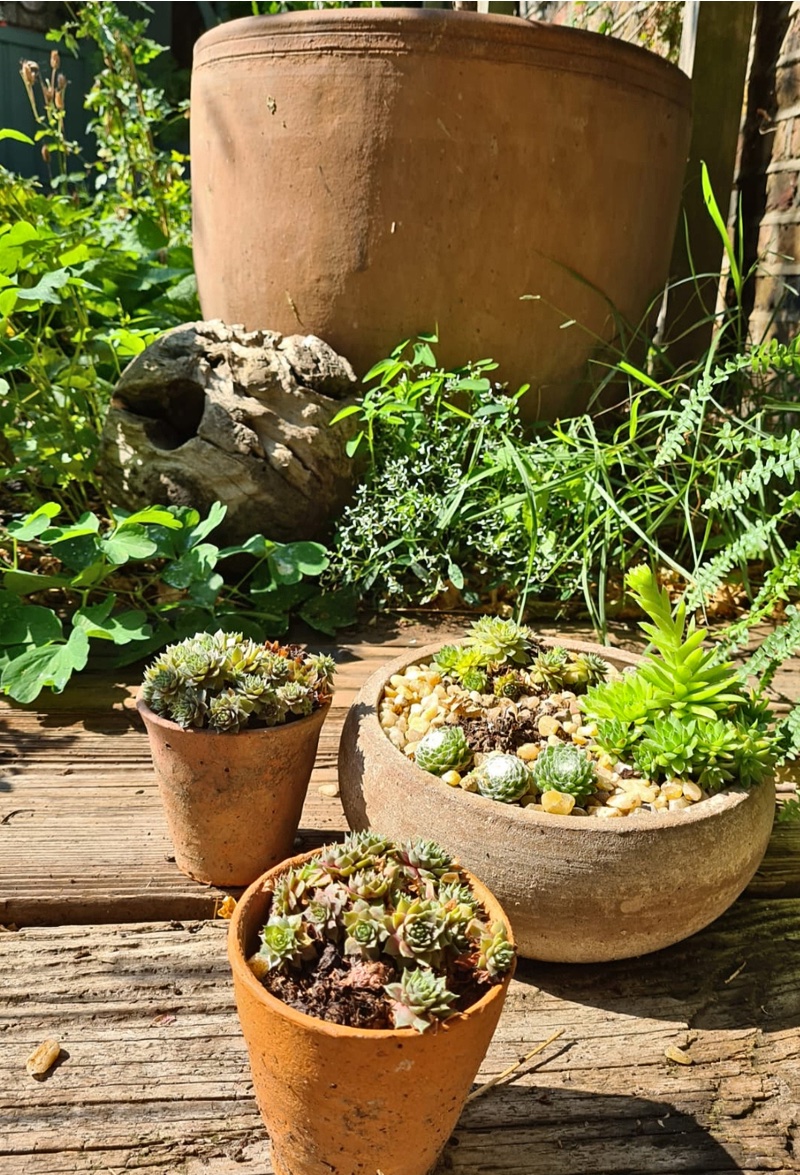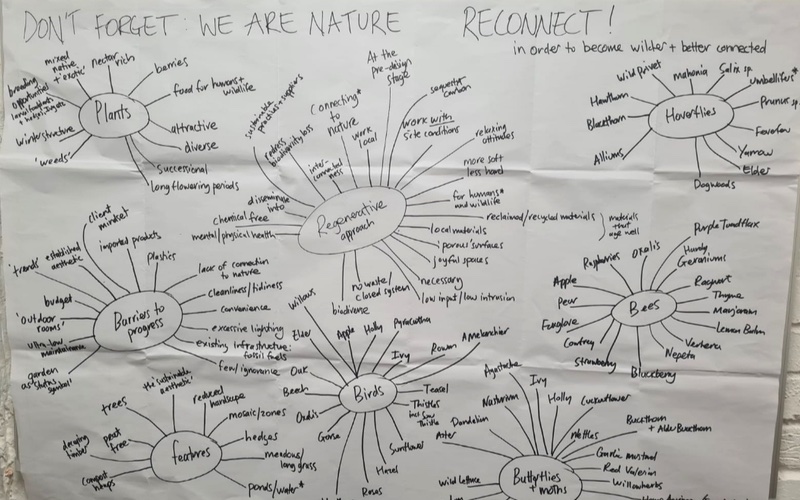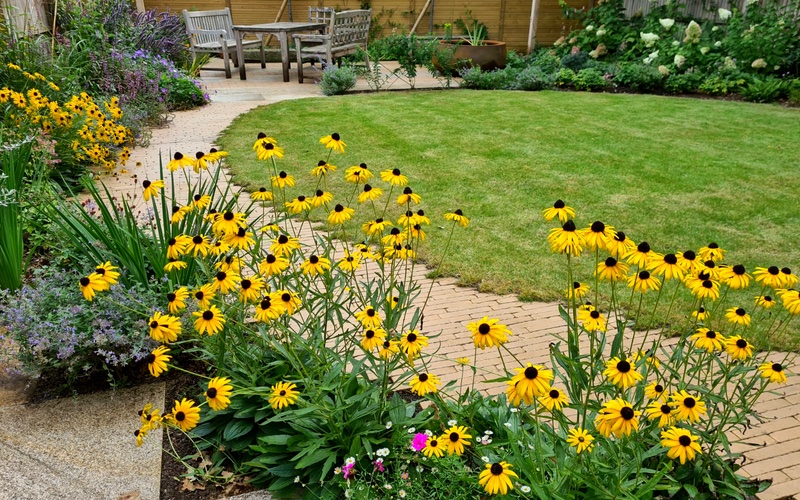THE LANDSCAPING SOLUTIONS BLOG
Welcome to our Blog. Inspiration, updates and industry trends from the team at Landscaping Solutions.
THE SUSTAINABLE AESTHETIC
In late 2019 we collaborated with Jilayne Rickards on a small urban garden she designed for a great client in North London. Jilayne christened the scheme ‘The Urban Retreat’.

The Urban Retreat in North London, designed by Jilayne Rickards and built by Landscaping Solutions.
Jilayne’s vision was for the garden to be both beautiful and sustainable. In December last year we discovered the garden had picked up four British Association of Landscape Industries awards. The most satisfying of these for us was the award for best use of recycled and reclaimed materials. The recognition this garden received from BALI and the interest and acclaim it has garnered from the wider public offers hope for what we call ‘The sustainable aesthetic’. The more media coverage gardens of this type obtain the more they will come to be considered desirable by the general public and the more likely their guiding ethos will become mainstream thought.

Reclaimed Douglas Fir decking, one of the many recycled and reclaimed materials used throughout the garden.
What is the ethos of the sustainable aesthetic and why is it important? The sustainable garden weathers well in the British climate, blends in with its surroundings, accommodates and encourages interaction with wildlife and does not damage the environment in its creation. It follows a number of principles;
Protect and nurture the holy trinity of soil, plants and insects. Do this and good things will follow. In ‘The Urban Retreat’ all soil was kept on site.
Reduce waste. In this garden all existing pots and planters were recycled along with the brick work. Paving sub-base materials were re-used where appropriate or sent for off-site recycling with any green waste produced. Energetic waste can also be reduced by designing closed systems and features that have multiple benefits. For example, planting Comfrey for its aesthetic appeal, ability to attract and feed insects, provision of composting material and medicinal applications.
We can further reduce waste by working with the existing lay of the land, soil type, microclimate, ‘hard’ and ‘soft’ vernacular, moisture levels, ‘habitat’ type, etc. The existing garden had a woodland edge feel and Jilayne used this to inform her plant choices. Woodland edge gardens are cooling and relaxing in the heat of a city summer.

Existing pots and planters were recycled and wildlife friendly planting was retained.
Useful, wildlife friendly planting was retained and any unwanted plants were donated to other gardeners. A mature Elder was a prominent existing feature. What plant can better connect us to the environment and other lifeforms? In winter it looks a wreck and we wonder will it manage to limp on through to spring? But what a change once the sap starts to rise. The leaves come on early, connecting us to the cycle of re-birth out of decay. The summer flowers are an insect magnet and can be made in to refreshing drinks. The autumn berries feed birds and small mammals whilst boosting our immune systems through winter when processed in to medicinal food and drink. Dried out Elder canes are also the best material for the hand drill-one of the first ways our ancestors kindled fire. Try it yourself to fully appreciate their achievements! Plants of this kind re-connect us with our history and birthright and, in doing so, help dispel the illusion that we are somehow ‘outside’ of nature. Through constant exposure to the damaging aspects of our existence we have grown to believe degradation is our hallmark. Gardens are the one of the arenas in which we can reassert the positive elements of human intervention and perhaps see our purpose on this planet.
Specify plants and hardscape that don’t need mollycoddling. Opt for resilient plants and stone and timber types that don’t need constant sealing or cleaning. Reclaimed materials achieve this end and also tick the sustainability box- they have not been newly created and therefore no further finite resources have been consumed. In terms of timber, we used reclaimed Douglas Fir decking and shelving and reclaimed Oak for the seating block/retaining wall in this garden. Reclaimed slate and granite was used for the paving. Jilayne and the client went shopping in local markets for the second hand furniture, fixtures and fittings. All the reclaimed materials were of British provenance. When reclaimed wood cannot be used specify locally sourced FSC-certified timber from trusted suppliers.

Reclaimed timber, slate and granite were used throughout the garden as well as second hand furniture, fixtures and fittings.
Permeable surfaces allow rain water to percolate back in to the ground and to that end gravel was used extensively in this garden. More generally, look to make surfaces more porous with the aim of increasing biodiversity. Block and brick retaining walls could be replaced with gabions which allow unwanted existing materials such as paving and walling to be used as in-fill.
Sustainable gardens aim to be as ‘soft’ as possible. Planting should be diverse, successional and nectar-rich. Utilise a range of trees, shrubs, climbers, grasses and bulbs to provide food and shelter for wildlife. Don’t forget; attractiveness to humans is of equal importance if the garden is to be considered a success by the client!
Go easy on garden lighting and chemical weed and pest control. Neither were used in this scheme.
However, the garden wasn’t a perfect example of sustainability. There were a number of areas where our activities were damaging;
- Cement and adhesives were used. Both material have a high environmental impact.
- Fossil fuels were consumed and pollutants produced in travelling to and from site.
- Space restrictions dictated all deliveries were bagged. To reduce waste specify loose deliveries wherever possible.
- Gravel extraction degrades wildlife habitat.
How can we improve? At Landscaping Solutions we are committed to continual professional development through seminars, courses, workshops and personal study. Integration of environmental assessments to our CDM process helps us think about how we can reduce our impact and guides our landscape design decisions and installation techniques. This is a great tool but can only take us so far due to the fact that much of the raw information is based on intuition. There is a need to develop an industry accepted framework to help us better understand the relative impact of various materials and practices. For instance, we might assume artificial turf to be more impactful than paving but in some instances artificial turf allows the ground to ‘breath’ more than paving. Leave artificial turf to its own devices and it develops into ‘habitat’ much quicker than paving, rapidly hosting an array of plant and invertebrate life. However, can it be recycled satisfactorily? And which of these is most environmentally impactful; quarried British Yorkstone or Italian porcelain? What about quarried Indian sandstone v Italian porcelain? Or Indian sandstone v Indian porcelain. Yorkstone v Portland Stone? Portland stone from open cast extraction v undersea deposits? These are complicated questions.

Regular brainstorming sessions helped guide our design decisions and installation techniques.
Good reliable information will enable us to compile a database of suppliers employing sustainable practices. For ‘The Urban Retreat’ we used Ashwells Timber and CED Stone.
Responsive clients might be encouraged to engage with food production be it wild or cultivated and on whatever scale possible. This takes the pressure off the industrial agricultural system, promotes personal resilience, self-sufficiency, understanding of our role in the ecosystem, empathy with other life forms and mental and physical health. Studies have shown low-input vegetable and fruit allotments to be the most biodiverse land use in the country. They can be further improved by providing a body of water and adding on-site composting facilities.
One last piece of advice; don’t forget to have fun!
PROS OF PERMACULTURE
Landscaping Solutions MD Ben West explains what permaculture is and its sustainability benefits.

An example of permaculture garden design, built and maintained by Landscaping Solutions.
Last month I started to consider steps we might take, in lieu of top down leadership, to fashion solutions to the ‘sustainability problem’. Those in the industry looking to cut a path toward adopting fully regenerative practices have a ready sharpened tool in the form of ‘permaculture’, a system that can be applied to garden design as well as every other aspect of our lives. Permaculture design offers guidelines by which we can operate sustainably on a personal level and positively influence the actions of our clients.
Permaculture recognises the sustainability problem is rooted in the prevalence of economic models which overlook diverse, traditional and local operations in favour of monolithic global systems dependent on mass consumption of fossil fuels and resulting in cultural and environmental degradation. Permaculture eschews the global model and works to preserve and enhance the best of the existent. In short, it is the design of sustainable human habitats.
Australians Bill Mollison and David Holmgren introduced the concept with their 1978 book ‘Permaculture One’. They saw the current economic system as flawed and took inspiration from the propensity of natural ecosystems toward rejuvenation. Permaculture design closely observes nature, notes the connections between its manifold elements and uses these relationships to inform its work. It is opposed to the myth of separation and the harmful ‘survival of the fittest’ concept of nature in favour of a view of the natural world as a host of symbiotic relationships and interconnected ecosystems.

The difference between ‘standard’ garden or landscape design and permaculture design lies with the lens through which the decision making process is viewed - permaculture ethics. Simply stated, these are: Earth care, people care and fair shares. These principles inform all design choices. Earth care acknowledges our dependence on a healthy planet for survival and advocates its veneration and conservation. People care recognises the physical and emotional needs of modern humanity, and looks to utilise technology and intelligent design to avoid problems that made formerly sustainable modes of living untenable. Fair shares asserts the finite nature of the Earth, the need to establish limits to human consumption and balanced distributions of ‘wealth’.
Much modern garden and landscape design revolves around making things pretty rather than useful. Many plans please the eye but lack technical detail or practical function. We should not reject the aesthetic; rather, this aspect should flow naturally from a meticulously researched and beautifully realised design. Permaculture is all about the details.
This pragmatism is evident in the key concepts of ‘zones’ and ‘sectors’. Zoning brings elements requiring most attention closest to centres of human activity; vegetables and fruit close to the kitchen, for example. Less frequented areas are set aside for lower maintenance features. Sectoring considers the influence of exterior factors such as wind, rainfall, light, views, local flora, fauna and architecture, and incorporates these into the design to create beneficial connections between the elements. The needs of one are met by the outputs of another; soft vegetative prunings become mulch via the compost heap, for example. Each element performs multiple functions thus maximising the overall efficiency of the whole. The aim is to form a ‘closed system’ in which energy, nutrients and resources are recycled rather than lost. Like a natural ecosystem, nothing goes to waste and everything has value.
In order to achieve our regenerative goals, we must work wisely with what we have rather than expend valuable energy in a protracted and dysfunctional struggle to bend nature to our will.
Visit www.permaculture.org.uk for further information and feel free do drop us a line with your thoughts and feedback on Ben’s article at info@landscapingsolutionsltd.co.uk.
LOSING TOUCH WITH NATURE

There has been a lot of talk in the media lately about Nature Deficit Disorder and while its not recognised as an official medical condition, a great deal of research has shown that Nature Deficit Disorder is something that can result in behavioural problems in a vast number of people, so it might be something that’s worth taking seriously.
The term itself was first coined in the novel ‘Last Child in the Woods’, by Richard Louv and refers to the fact that children (and human beings in general) are spending less and less time outside, resulting in a range of behavioural issues.
With strong links to Nature Knowledge Deficit, (a term describing the fact that we don’t know nearly as much about the natural world around us as we did in ages past) Nature Deficit Disorder is clearly a symptom of the modern lifestyle and a prime example of how we are drifting away from our natural habitat.
In the modern world, it is easy to lose touch with nature. We forget what an important part of our existence it is. There is a reason that people use to worship nature in the past, because it is essential to our survival as well as our well-being. A growing number of people are losing touch and forgetting to interact with nature on a regular basis.
A common cause for the onset of Nature Deficit Disorder is people’s growing fear of the danger the outside world presents, with many people choosing to spend more and more time indoors through fear, and passing this fear on to their children.
The gradual loss of natural surroundings is yet another contributing factor. As housing developments increase we lose fields, green parks and woodland as they are steadily replaced by brick and concrete structures. The lack of interaction with the great outdoors and being denied the opportunity to explore nature trails, woodlands and wildlife can be damaging. When you factor in the introduction of modern technology (video games, computers, mobile phones) it all contributes to a more insular and indoor lifestyle.
Ultimately the culmination of these factors can quickly result in a lack of respect for our natural surroundings, in children and adults. This in turn results in a decline in health for the Earth and the people that inhabit it.
Research has shown that the great outdoors has the power to make a person feel calm and tranquil, even something as simple as standing on the ground with bare feet can be enough to help you feel connected to nature again and feel its calming effect.
When it comes to tackling the effects of Nature Deficit Disorder something as simple as landscaping and maintaining your own garden can go along way to reconnecting with nature. Creating beautiful areas for you to sit and relax in, or even sections where you can regularly garden and plant flowers, are all parts of the process.
Something as simple as spending more time in your garden is enough to start reversing the effects of Nature Deficit Disorder. So when it comes to planing your garden and making it a more relaxing place to be, make sure you take landscape design into consideration or maybe let the professionals create something truly fantastic for you.